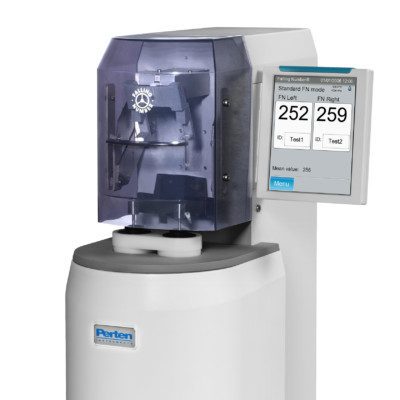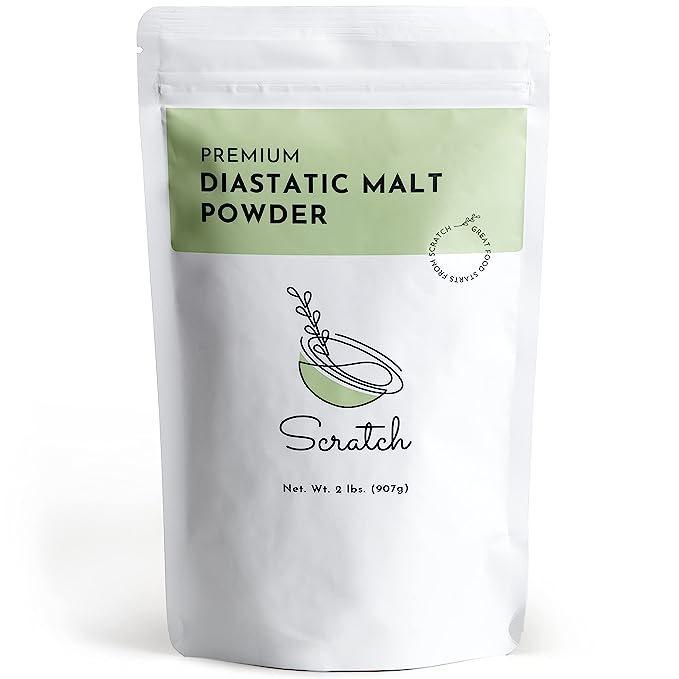Cairnspring Mills recently (early summer 2023) modified their Trailblazer flour which is used by our greater Seattle area bakers to a blend. This blend doesn’t have the same enzymatic activity as the previous version. As a result, we recommend adding 2g – 3g of diastatic malt per loaf to the autolyse step.
Below is the email sent to our bakers on Saturday, July 22nd.
This email is an update on a “rising” issue many are experiencing, including myself, with our bread bakes over the past 3-5 doughnations.
I think we’ve finally cracked the code. It seems to result from the shift in the Trailblazer flour, which is now a blend of wheat vs a single varietal of Yecora Rojo. This new blended TB flour has a higher falling number (FN), one of the metrics flour manufacturers often test for future bread performance. The WSU bread lab has a machine that runs the Hagburg Falling Number test.

The machine at the lab, looks roughly like the above. It is used to measure the enzyme activity in flour. The FN (Falling Number) of flour is related to the amount and activity of cereal enzyme α-amylase, which is present in wheat after harvesting.
The FN is the time in seconds required for a device to fall a measured distance through a hot flour/water mixture while heat is applied. (Literally tracking the speed of a plunger through the slurry.) If the enzymatic activity is high, the starch is rapidly broken down (liquefied) during gelatinization. So then, the device falls through the relatively liquid paste in a short time. A less viscous fluid opposing less resistance to the flow means the FN is low. On the other hand, if the enzyme’s activity is low, it takes longer for the device to cover the distance of its fall. This means the falling number is high. See the Test
Which brings us to our current Trailblazer.
I do not know the exact falling number for our current TB, but it is reportedly HIGH by Mel Darbyshire, executive baker at Grand Central, who purchases silos of the stuff. And in the shop, meaning at Grand Central, they compensate for the higher falling number, lower enzymatic activity by adding diastatic malt. Diastatic malt vs nondiastic malt the first is cured at low heat and still has its enzymatic properties; nondiastic is mostly lovely sugars we like for browning.

If you are experiencing problems with your loaves, they aren’t rising like they used to, a little Diastatic Malt Powder is your friend. It might be difficult to find at your local store, but you can get it at Amazon, King Arthur, Web Restaurant, and other suppliers.
A little goes a long way. And there is a lot of information on the web. I recommend adding the diastatic malt powder at the beginning of the autolyze phase; you can also add it during the mix if you prefer. How much to add? The range is quite significant: Diastatic malt should be added to the total flour weight in the range of 0.5 to 2%. One loaf is approximately 600g; let’s start at .02%, which would be 3 grams per loaf; making 4 loaves, you’ll want to add 12 grams. Easy math and reasonable assurance for better activity.
There is a lot of information on making your own diastatic malt, for all you DIY’ers. Here is one source for the process: The Fresh Loaf. Another recent piece by talented baker & blogger Maurizio Leo – The Perfect Loaf – What Is Diastatic Malt
I’m so grateful we have a solution to this prickly problem; many of us were wracking our brains about why our near-perfect loaves were acting up. This is part of the issue. In addition, I will put the Organic Expresso to the test. It has a lower falling number and shouldn’t require the diastatic malt. I will also check with Cairnspring to understand whether the current FN issue will be persistent or seasonal. This is freshly milled wheat and flour and part of the ongoing variables that professional bakers manage. We’ve been blessed with so much consistency that it caught us a bit flat-footed, and flat loafed!
Back to FN & Diastatic Malt – Some of you may not have any issues. So this can be a tool in your toolkit down the road. For those of you who are, I’ve shared the beginning of the breadcrumb trail. Some of you will go quite deep down this rabbit hole, and I look forward to hearing from you and your continued learning.
2023-08-16 UPDATE:
Feedback from bakers using the new flour is that the diastatic malt has indeed done the trick. Loaves are back to standard heights.
Hanne, this is a great question and I’m sorry for the delay. We are recommending a small amount of Diastatic Malt to TB even if purchased May 2023. It shouldn’t hurt and it might help if it is the “blended” version. We’re in conversations with Cairnsprings right now to understand the future disposition of the flour. We will keep you posted on those conversations.
Do I need to add diastatic malt to TB received with the May 2023 order? Thanks.
Checked on the shelf life of Diastatic Malt Powder. Dr. Google says it’s about a year, and that can be prolonged by keeping it in the freezer.
We talked about using Diastatic Malt today during the baker debrief. Several bakers reported better success with a smaller amount of diastatic malt 2 to 3 g per loaf you are baking. Give this a try and report back.

